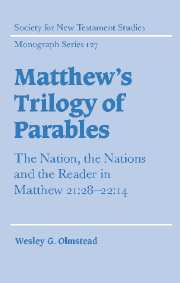Book contents
- Frontmatter
- Contents
- Acknowledgements
- Part one Prolegomena
- Part two The trilogy in narrative-critical perspective
- Part three The trilogy in redaction-critical perspective
- 6 The trilogy in redaction-critical perspective
- 7 Conclusions
- Appendix The text of the parable of The Two Sons
- Notes
- Bibliography
- Index of passages
- Index of selected topics and modern authors
6 - The trilogy in redaction-critical perspective
Published online by Cambridge University Press: 22 September 2009
- Frontmatter
- Contents
- Acknowledgements
- Part one Prolegomena
- Part two The trilogy in narrative-critical perspective
- Part three The trilogy in redaction-critical perspective
- 6 The trilogy in redaction-critical perspective
- 7 Conclusions
- Appendix The text of the parable of The Two Sons
- Notes
- Bibliography
- Index of passages
- Index of selected topics and modern authors
Summary
The reading of the trilogy offered in chapter 5 concentrated on the trilogy's rhetoric and the inclusion of the reader. In this chapter our focus shifts from reader and rhetoric to author and composition. Like the wider narrative to which it belongs, this trilogy of parables is marked by an intriguing combination of old and new, of tradition and redaction. Here we examine the manner in which the old has been made new, offering not so much a redaction-critical reading of the trilogy as a discussion of the distinctive emphases that arise from this redaction. An examination of the sources upon which the evangelist drew in composing this trilogy introduces the chapter and lays the foundation for the subsequent discussion of the distinctive treatment they receive at his hand. But, although my approach shifts dramatically, my interest in the responses that the evangelist intended to elicit from his readers remains central.
The sources of the parables
The Two Sons
The three parables that compose the trilogy pose distinctive challenges to a redaction-critical investigation. The Two Sons is unique to Matthew and there is little agreement about the sources that stood behind the Matthean parable. For Jülicher, the parable proper was an authentic word of the authentic Jesus. Jeremias concurred with this judgement and attributed the story to ‘the special Matthaean material’. For Van Tilborg, as we have noted, both this story and the trilogy in which it now stands are pre-Matthean.
- Type
- Chapter
- Information
- Matthew's Trilogy of ParablesThe Nation, the Nations and the Reader in Matthew 21:28-22:14, pp. 133 - 159Publisher: Cambridge University PressPrint publication year: 2003



